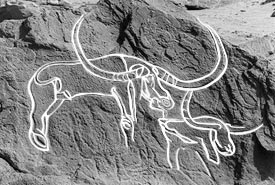
A variety of rock paintings of the bubalus (Bubalus antiquus) show naturalistic or rather realistic traits, while other animals (elephants, rhinoceroses) predominantly show decorative features. These are no schematic representations, but unique form findings. In comparison herewith representations of man (cf. special album) are much simpler as to their expression and more limited in formal respect. Maybe this difference sheds a light on man’s approach to animals and to their herds in particular.
Among the most ancient representations we encounter big game species, later on followed by herds of cattle, and last but not least by human beings.
Looking at big game representations seems to suggest the conclusion that the Sahara artist must have tried to put special emphasis on achieving body and spatial impressions with the simplest means. The way to lower a horn at a 90° angle in a variety of bubalus drawings, in order to find a great formal solution for the horns, shows a competent and surprisingly artistic will. Other means to create three-dimensionality are three quarter representations or double line work.

The formal solution of animal presentations suggest an extremely exact oberservation of the physique of animals. Each single animal presentation is an individual finding of form.
While folk art in the Appenzell or in Toggenburg is based on a comparatively reduced catalogue of forms, on repetitive standard forms so to speak, those who have created the Messak Rock Art seem to be playing with forms and to experiment with them. The analysis becomes more difficult the moment when two representations are superimposing each other.

Above all the changing perspectives are worth the utmost attention. Sometimes animals are being represented from the side, sometimes in perspective but often also in a surprisingly multi-perspective combination of both.

With that human beings who have made them were far ahead of European art where the perspective only occurs from the Renaissance onward. The great difficulty for them was to achieve, with simple lines, images of body and of space which can easily be realized in painting with colours and with chiaroscuro contrasts. Especially noticeable are the numerous attempts to realize a spatial impression with simple means.

Also the way to turn down front the horns by 90° on some of the bubalus drawings in order to find a great formal solution

for the horns, shows a self-confident artistic will.
It may seem arbitrary that, with some representations, we loosely associate Pablo Picasso

or Marcel Duchamp

or Keith Haring

or to Cubism

But maybe we, here, are dealing with archetypal ideas of form which go deeper than traditions and historical developments and beyond geographic spaces.
It remains a mystery how this artistic perfection has been achieved. Though human beings hardly could have had much contact among each other because of the distances, one can talk about a great connected cultural area. It hasn’t necessarily been an advanced civilization but those human beings have clearly had a highly developed art language, and this from the very moment on that the first drawings known to us have been made. To which degree these creations were conscious can hardly be decided. It would be too good could we know it.
In the album "Comparisons of Style with Big Game" we’ll be going into a number of representations in detail.

